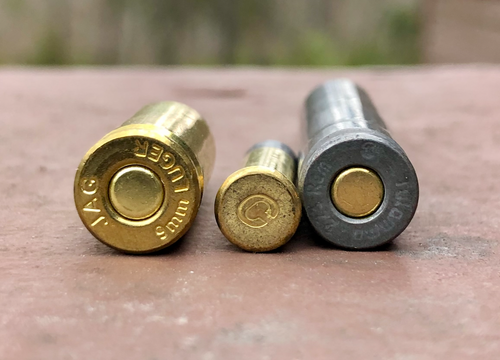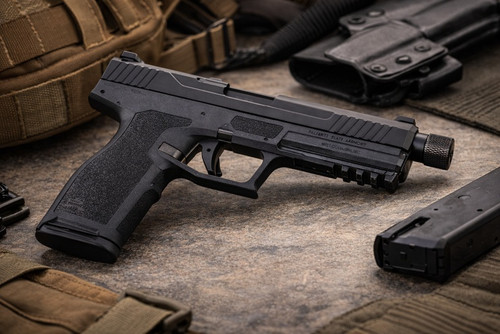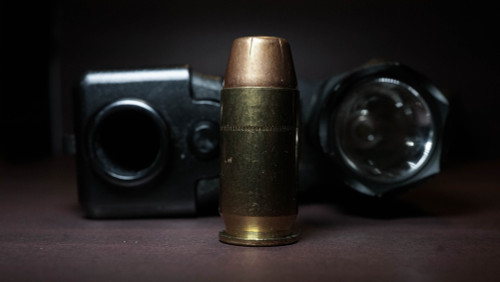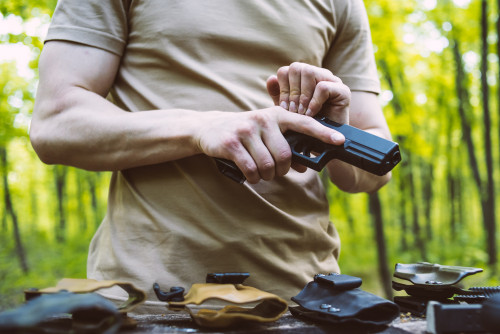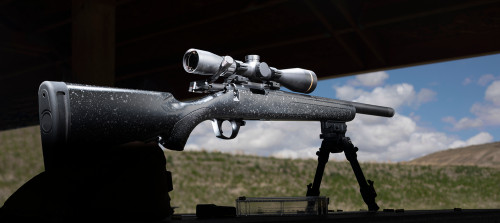Centerfire and rimfire cartridges are both means to the same end; sending lead downrange toward a target. The ways they get to that end are different due to the construction of each kind of cartridge. One isn’t inherently better than the other, but there are times when one has advantages over the other.
Both centerfire and rimfire cartridges have the same basic components: A bullet, a case, gunpowder, and a primer (in the case of centerfire rounds), or a priming compound (for rimfire ammo).
Let's dig into the differences between each type of ammo to see which is right for your shooting goals.
Bullet Construction 101
Let’s get semantics out of the way first: Centerfire and rimfire represent the two basic types of loaded ammunition, called cartridges or rounds. Calling a loaded, ready-to-fire cartridge a bullet isn’t exactly misleading, just a bit incomplete.
The bullet is the projectile that is expelled through the barrel. The case is what holds the bullet, gunpowder, and primer or priming compound all together to make a cartridge or round. That said, only the most uptight shooters will have a fit if you call a round or cartridge a bullet. Don’t lose any sleep over it.
Rimfire Ammo
Rimfire is the gateway drug into shooting sports. It’s cheap, fun, and always leaves you wanting more.
Look on the ground of any gun range in America, and you’ll see more .22LR (Long Rifle) rimfire brass than any other caliber. Why? There are a few reasons, but the biggest one is price. You could get .22LR for roughly $.06 per round in early 2023. But in years past, prices at roughly $.03 per round weren’t uncommon. Compare that to the average price of a .223 Remington or 9mm Luger handgun at $.25 per shot and you can see why the .22LR is as popular as it is.
The most notable aspect of rimfire is its namesake, the rim from which it is ignited and extracted from your gun’s chamber. Rimmed cartridges have a base that is wider than the body of the brass case, hence the rim. Whereas a centerfire cartridge is fired by a hammer or firing pin striking a primer in the center of the cartridge, rimfires are ignited by a firing pin striking the rim, which houses a priming compound that acts like the primer in a centerfire.
Note the primer strike on the rim of the rimfire .22LR on the left, and the center of the centerfire 9mm on the right.
During manufacture, after brass cases are extruded to form, they get a dab of priming compound dropped into the case that is then spun rapidly, sending the compound to the rim of the case. While this is a marvel of clever design, it’s also the Achilles’ Heel of the rimfire cartridge.
Much rimfire ammo is destined for bulk packs of 300, 500, or even more rounds. When the goal is to fill boxes with ammo, focus can shift to quantity over quality. Shooters occasionally come across rounds that don’t fire in these huge boxes. This is the result of uneven application of compound within the rim. But, when the round is rotated so the firing pin strikes another part of the rim, they often fire eventually. Occurrences like this are far less common today than they were even a few years ago, but it’s still something to be aware of. It’s for this reason that rimfire is often dinged as less reliable than centerfire.
However, getting a high quality .22LR offering often negates this setback and offers better consistency that also improves accuracy and precision.
Benefits of Rimfire Ammo vs. Centerfire
Rimfire ammo also has a host of benefits over using centerfire. But by far, the biggest one is cost. Its small size alone keeps cost down, and most of it is created in bulk with an eye toward plinking and blasting ammo. A lot of this bulk ammo has good enough performance, but there is some freaky-accurate match-grade .22 out there that Olympians and competitive shooters rely on.
Rimfire ammo is also useful for more than putting holes in cans on grandpappy's farm. Competitive pistol and rifle shooters who aren’t flush with cash or sponsored by an ammunition manufacturer generally reload their own ammo or use a .22LR trainer firearm in place of their competition gun. This offers a host of benefits. With a trainer firearm, you get the same size, weight, trigger, optics, and function of the real deal while spending a fraction of the cash on ammo. This lets you train more and ultimately become better with your main gun.
Another obvious benefit of .22 and other rimfire cartridges is their reduced recoil and blast. This makes rimfire more appealing to beginners and younger shooters alike. Scope bite is a real thing, and stitches between the eyes can turn off new shooters in an instant.
Many rimfire cartridges are useful for hunting as well. Many squirrel hunters prefer a headshot with a .22 to a 20 gauge. If you’ve ever unexpectedly bit down on a shotgun pellet, you'll know why. High-performance cartridges such as the .22 Magnum, .17 Hornady Magnum rimfire (HMR) and others are great for blasting varmints across open prairie. The .17 Winchester Short Mag (WSM) is strong medicine for coyotes, bobcats, and other medium-sized predators.
Rimfire Cartridge Examples
We’ll use the general term “rimfire,” but the vast majority of rimfire is the .22LR. It’s so much the majority that it’s almost not worth talking about the others. The .22 Magnum is used in small revolvers as a marginal self defense cartridge, and the .17-caliber variants are useful for varminters looking to zap woodchucks and prairie dogs (but only on windless days).
While the .22LR is certainly the most popular rimfire cartridge, it isn’t the only one. Most rimfire cartridges are of small caliber. In fact, the .22LR is one of the biggest in terms of bullet diameter. Many use a .22-caliber bullet in cases of varying lengths, including the .22CB Short (7.2mm case length), .22 Short (10.7mm), .22LR (15.6mm), and .22 Magnum (26.8mm).
For more serious work and a greater degree of precision, the 5mm Remington Magnum is a great target round, as are the .17-caliber offerings. No matter which rimfire round you choose, you’re getting a cost-effective, low recoiling, fun cartridge. Just be aware of the limitations. Don’t expect match-grade performance from a huge bucket o’ bullets and you’ll be perfectly satisfied.
Centerfire Ammo
Determining whether a cartridge is a rimfire or centerfire is like trying to tell if a critter is male or female: if the answer isn’t immediately apparent, you gotta look where the parts are. In the case of ammo, the parts are on the bottom or back of each round.
Centerfire ammo has a primer dead in the center on the back or bottom of the cartridge. It’s usually a silver or gold color and looks like a button. It acts like a button in that when it’s smacked by a firing pin or a hammer, the combustible compound within it ignites, sending a spark through the flash hole in the case. The flash hole is a tiny hole inside the bottom of the case that separates the powder from the primer. The powder ignites when it meets the spark, which sends the bullet down the barrel.
Benefits of Centerfire Ammo vs. Rimfire
As a rule, centerfire ammo carries a handful of advantages over rimfire:
- Centerfire ammo is cleaner - How is this possible? Most centerfire ammo is jacketed, which doesn’t gunk up a barrel like the exposed lead bullets of many rimfire rounds. Also, there’s generally a greater emphasis on quality with most brass-cased centerfire rifle and pistol rounds. They usually enjoy higher quality and cleaner-burning powders than those found in bulk packs of rimfire ammo. There are exceptions with some Russian/European steel-cased ammo, but you get what you pay for.
- Centerfire ammo is more reliable - A centerfire cartridge’s primer is a separate piece of the cartridge that’s designed for one task: sparking a charge of gunpowder. Rimfire ammo is still pretty darn reliable, but it can be spotty in huge bulk packs of ammo. We’ll go into greater detail in the rimfire section, but suffice it to say that militaries around the world use centerfire ammo for a host of reasons and reliability isn’t the least of them.
- Centerfire ammo is more accurate - There are exceptions to every rule, but the rule is that the average centerfire rifle or pistol round has a greater degree of consistency than a rimfire round. Consistency is the bedrock of accuracy and precision. Centerfire bullets are held to tighter tolerances, powder is weighed more precisely, and cases are generally more uniform than their rimfire counterparts.
- Most centerfire cartridges are more powerful - All of the aforementioned qualities of centerfire cartridges allow them to be upsized and loaded hotter. Rimfire brass is super thin around the rim and crushing it with a firing pin in a high-pressure round risks case ruptures.
Because of all the above benefits, centerfire ammo is usually more expensive than rimfire (which is often produced in bulk). Centerfire rounds require lead, copper, brass, powder, and the standalone primers. Rimfire ammo uses tiny bullets and powder charges, with a priming compound inside the case. When you combine the quantities of material, extra steps necessary to produce centerfire cartridges, and a higher degree of oversight, costs naturally rise. But almost all centerfire rounds are worth the squeeze.
Centerfire Cartridge Examples
There is a far greater variety of centerfire ammo than there is with rimfire. The majority of the most popular handgun and rifle cartridges are centerfire.
The most popular handgun cartridge used for self defense, police, and military duty is the 9mm Luger. It’s a centerfire cartridge with a wide variety of options in terms of bullet styles and weights. The reliability, power, and cleanliness of centerfire ammo make it the perfect choice for more serious use. The 9mm Luger offers the ideal blend of terminal performance and magazine capacity.
If you want a little more stopping power for your autoloader, you can step up to the mighty 10mm. For a wheelgun, take a look at the .44 Magnum.
In the rifle world, centerfire once again dominates serious-use cartridges, meaning military, police, self defense, and big game hunting. The combination of power, precision, reliability, and quality is unbeatable unless you’ve got a plasma rifle in the 40-watt range.
The most popular centerfire rifle cartridge is the .223 Remington/5.56x45mm NATO. The NATO moniker denotes its official adoption and use by NATO forces around the globe. It’s not the only NATO service round, but it’s typically the go-to for shoulder-fired small arms. The NATO round operates at a higher pressure than the commercial .223 Remington, so do not use 5.56 ammo in a gun chambered for .223. Just don’t do it.
Other popular centerfire hunting loads are the do-all, ultra versatile .308 Winchester (7.62x51mm in NATO spec), the flat-shooting 6.5 Creedmoor, the proven and venerable deer whacker .270 Winchester, and your daddy’s .30-30 Winchester. These are mainstream cartridges that adequately serve the purpose of 90% of shooters, regardless of what marketing campaigns might say.
Centerfire is where you see the majority of innovations in ammunition. There are more uses and applications for centerfire ammo, which means the market is always striving to lure more shooters to adopt the latest whizbang cartridge. Regardless of your use and budget, you’re getting reliable performancewith centerfire whether you’re using a tiny varmint vaporizer or an anti-tank monster.
Final Thoughts
Using the right tool for a job is paramount to success. Both rimfire and centerfire cartridges excel at different tasks — your job is to choose which one is right for you in different situations. Whether you’re plinking, hunting moose, or shooting a mile, having the right ammo makes all the difference.
Whether you’re gearing up for the hunt of a lifetime or plinking around at the range, Proarmory.com has a wide selection of affordable, quality handgun, rifle, and shotgun ammo in stock and ready to ship to you. Our aim is to provide the best online ammo shopping experience possible — that means you can trust our site to protect your information. We’ll also deliver your ammo purchase straight to your door for the lowest possible shipping cost.
Browse our online store today for both rimfire and centerfire ammo. You’ll find just what you need at the best price possible.



